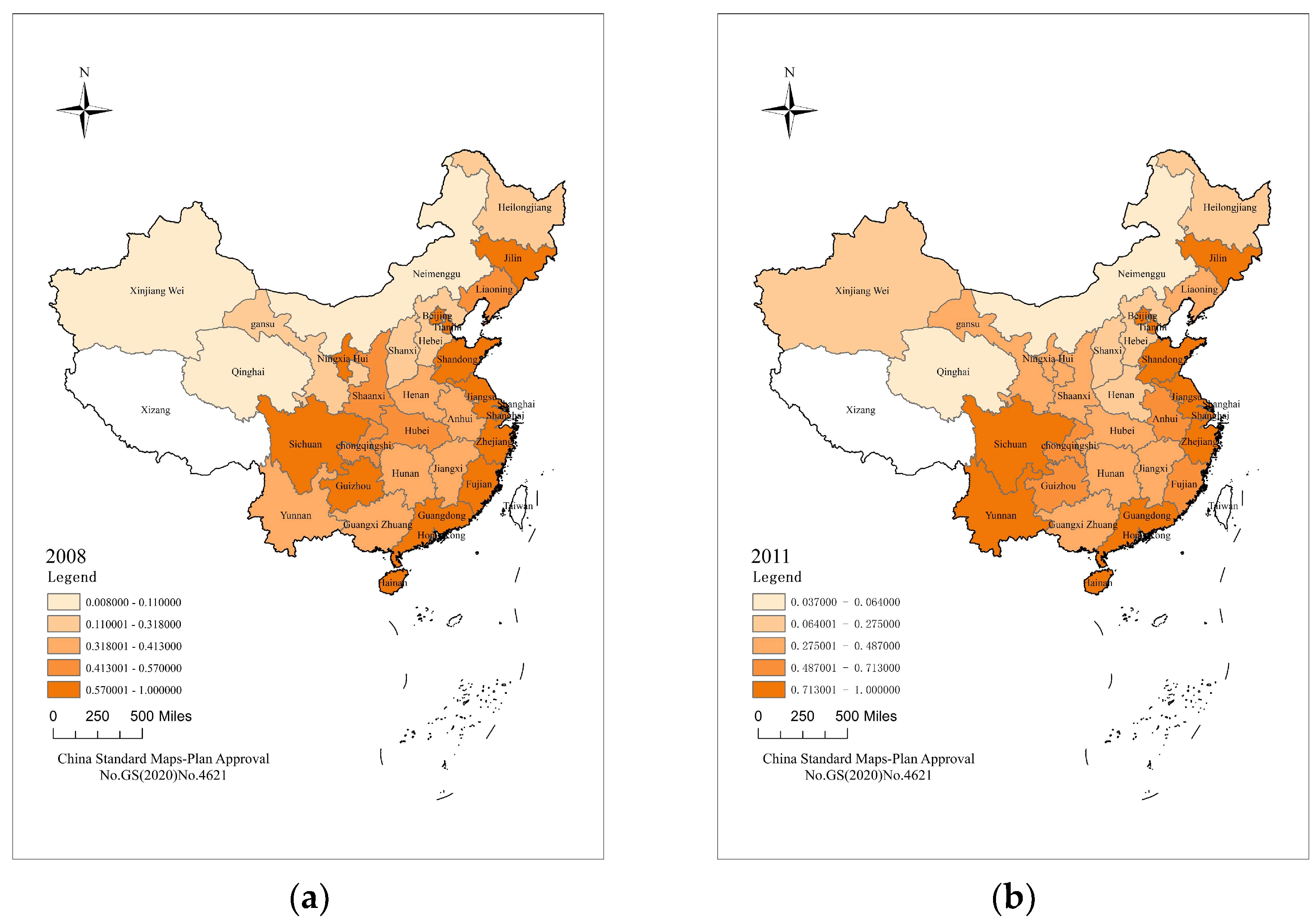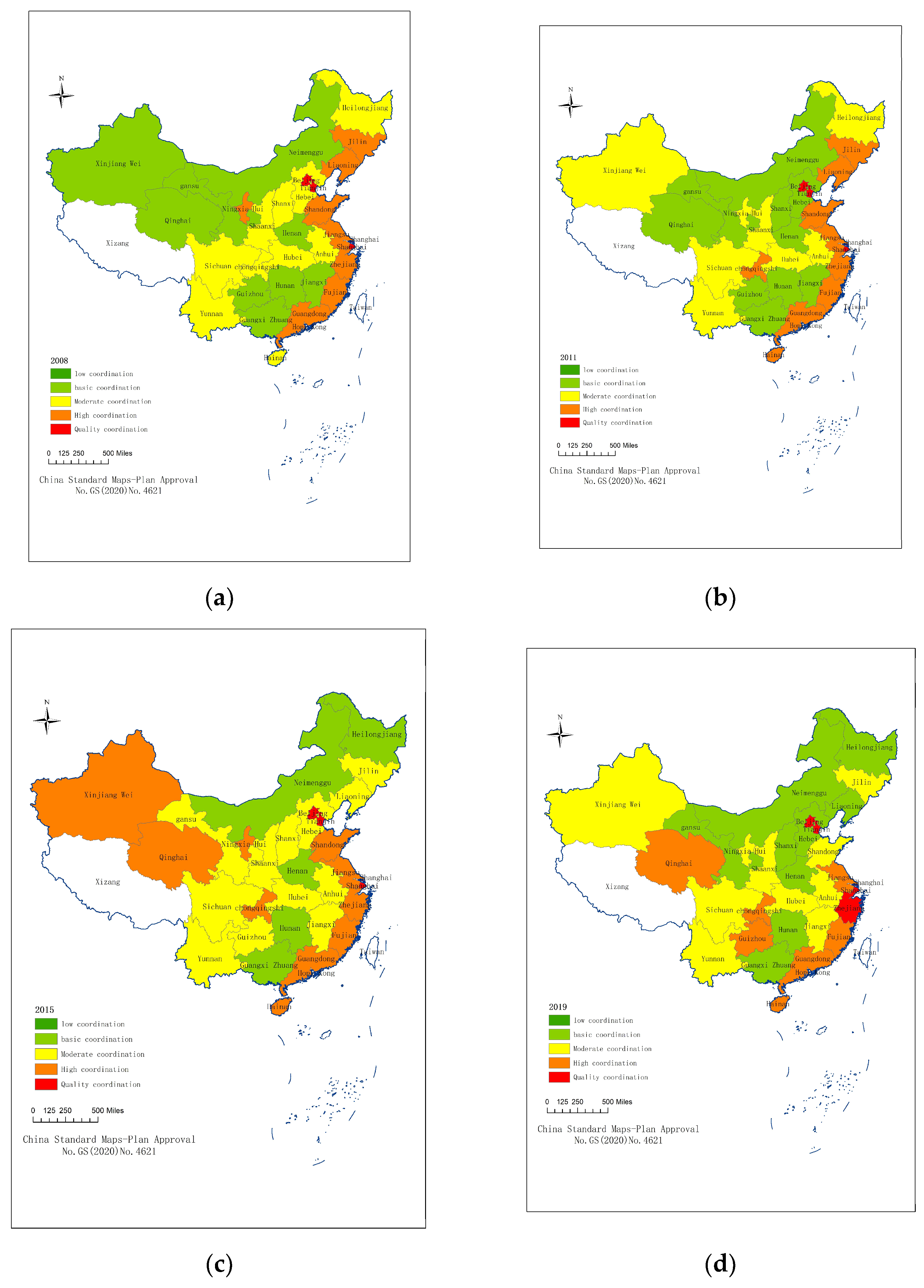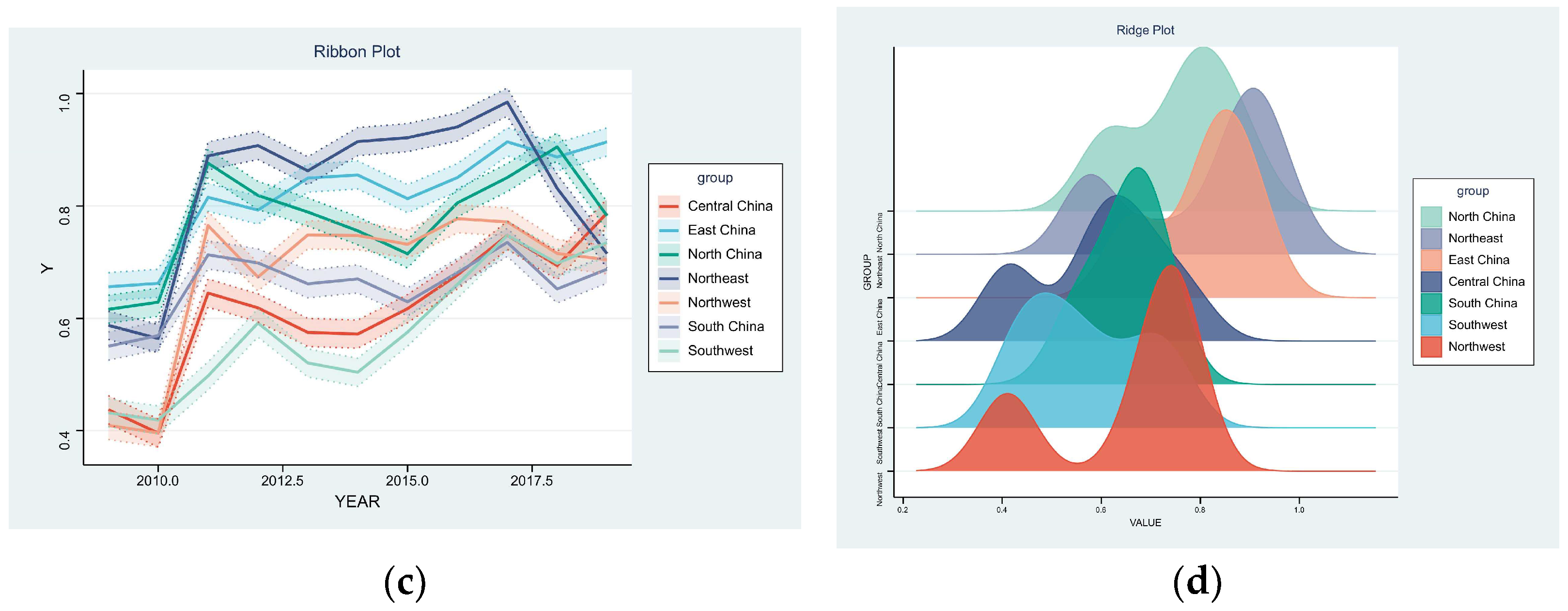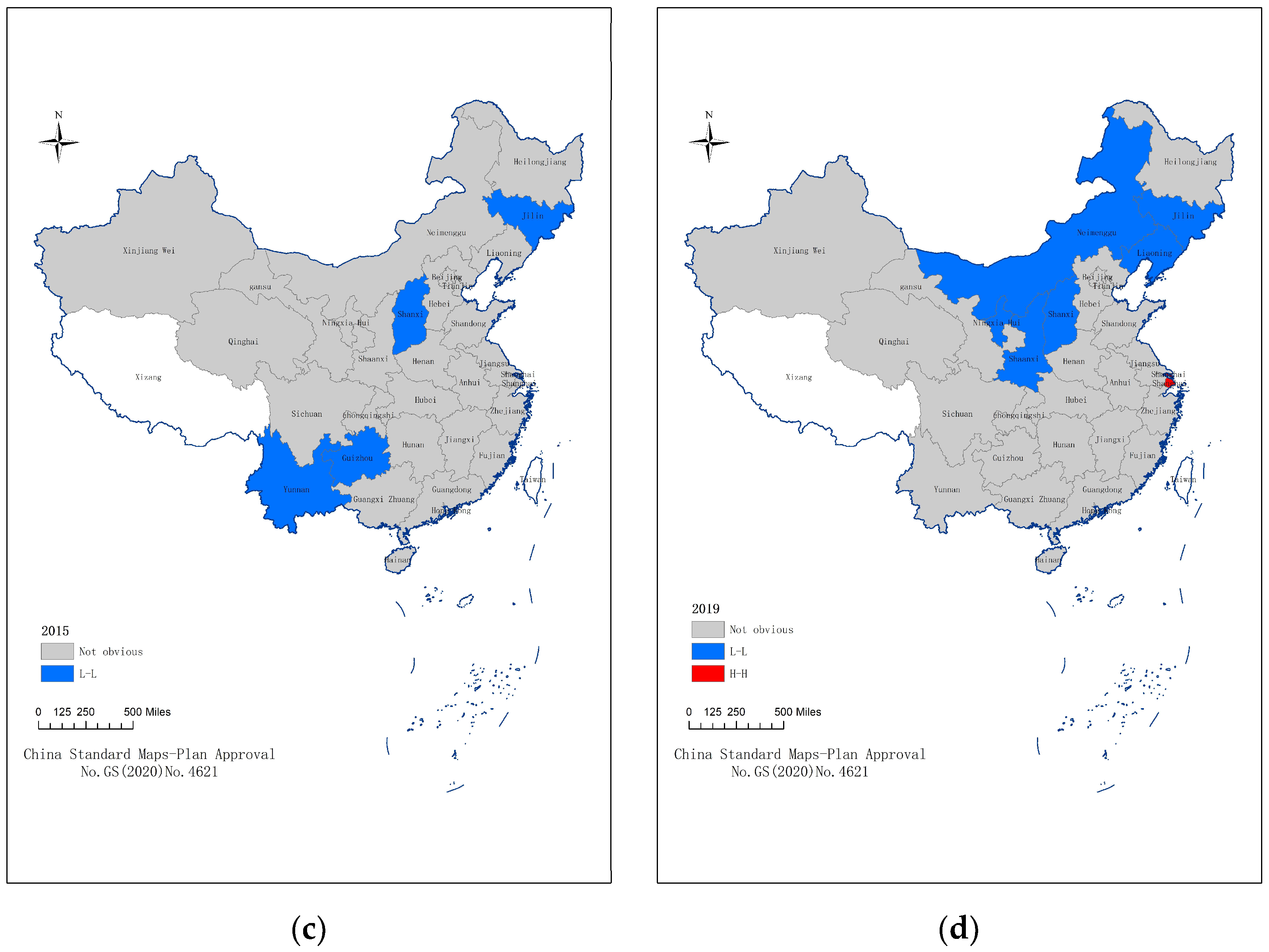The Coupling and Coordination Characteristics and Influencing Factors of Green Innovation Efficiency (GIE) and Economic Development Levels in China
Abstract
:1. Introduction
2. Data Sources and Research Methods
2.1. Index Selection and Data Source
2.2. Research Methods
2.2.1. Coupling Degree and Coupling Coordination Degree Model
2.2.2. SBM-DEA Model
2.2.3. Global Spatial Autocorrelation
2.2.4. Local Spatial Autocorrelation
2.2.5. Tobit Model
3. Analysis on Coupling Coordination Degree of GIE and Economic Development
3.1. Measurement of GIE and Economic Development Levels
3.1.1. Analysis of GIE Results
3.1.2. Result Analysis of Economic Development Level
3.2. Coupling Coordination Degree of GIE and Economic Development Levels
3.2.1. Analysis of Coupling Coordination Degree between the GIE and Economic Development Levels of Provinces and Cities
3.2.2. Analysis on Location Factors of GIE and the Economic Development Level
4. Spatial Correlation Pattern Analysis of Coupling Coordination Degree
5. Analysis of Factors Affecting the Coupling Coordination Degree between the GIE and the Economic Development Level
6. Conclusions and Suggestions
6.1. Conclusions
6.2. Suggestions
Author Contributions
Funding
Institutional Review Board Statement
Informed Consent Statement
Data Availability Statement
Acknowledgments
Conflicts of Interest
References
- Ke, H.; Dai, S.; Yu, H. Effect of green innovation efficiency on ecological footprint in 283 Chinese Cities from 2008 to 2018. Environ. Dev. Sustain. 2022, 24, 2841–2860. [Google Scholar] [CrossRef]
- Xu, S.; Wu, T.; Zhang, Y. The spatial-temporal variation and convergence of green innovation efficiency in the Yangtze River Economic Belt in China. Environ. Sci. Pollut. Res. 2020, 27, 26868–26881. [Google Scholar] [CrossRef]
- Bauhardt, C. Solutions to the crisis? The Green New Deal, Degrowth, and the Solidarity Economy: Alternatives to the capitalist growth economy from an ecofeminist economics perspective. Ecol. Econ. 2014, 102, 60–68. [Google Scholar] [CrossRef]
- Mirata, M.; Emtairah, T. Industrial symbiosis networks and the contribution to environmental innovation: The case of the Landskrona industrial symbiosis programme. J. Clean. Prod. 2005, 13, 993–1002. [Google Scholar] [CrossRef]
- Beise, M.; Rennings, K. Lead markets and regulation: A framework for analyzing the international diffusion of environmental innovations. Ecol. Econ. 2005, 52, 5–17. [Google Scholar] [CrossRef]
- Oltra, V.; Jean, M.S. Sectoral systems of environmental innovation: An application to the French automotive industry. Technol. Forecast. Soc. Chang. 2009, 76, 567–583. [Google Scholar] [CrossRef]
- Halila, F.; Rundquist, J. The development and market success of eco-innovations. Eur. J. Innov. Manag. 2011, 14, 278–302. [Google Scholar] [CrossRef]
- Albort-Morant, G.; Leal-Millán, A.; Cepeda-Carrión, G. The antecedents of green innovation performance: A model of learning and capabilities. J. Bus. Res. 2016, 69, 4912–4917. [Google Scholar] [CrossRef]
- Zhang, Y.; Chen, H.; He, Z. Regional green innovation efficiency and dynamic evolution of Chinese industrial enterprises: A three-stage super-efficiency DEA method based on cooperative game. Environ. Sci. Pollut. Res. 2022, 1–24. [Google Scholar] [CrossRef]
- Wang, L.; Ye, W.; Chen, L. Research on Green Innovation of the Great Changsha-Zhuzhou-Xiangtan City Group Based on Network. Land 2021, 10, 1198. [Google Scholar] [CrossRef]
- Luo, X.; Zhang, W. Green innovation efficiency: A threshold effect of research and development. Clean Technol. Environ. Policy 2020, 23, 285–298. [Google Scholar] [CrossRef]
- Jie, H. Overall optimization model of efficiency and performance of green technology innovation. Sustain. Comput. Inform. Syst. 2020, 30, 100501. [Google Scholar] [CrossRef]
- Lv, C.; Shao, C.; Lee, C.-C. Green technology innovation and financial development: Do environmental regulation and innovation output matter? Energy Econ. 2021, 98, 105237. [Google Scholar] [CrossRef]
- Ruan, J. An Empirical Study on the Efficiency of Green Innovation of Industrial Enterprises in China. In Proceedings of the 14th International Conference on Innovation Management, Tokyo, Japan, 7–10 February 2017; pp. 582–587. [Google Scholar]
- Zhao, T.; Zhou, H.; Jiang, J.; Yan, W. Impact of Green Finance and Environmental Regulations on the Green Innovation Efficiency in China. Sustainability 2022, 14, 3206. [Google Scholar] [CrossRef]
- Zhao, B.; Zhong, T.; Zhong, M. Research on Urban Green Innovation Efficiency Measurement and Spatial-temporal Differentiation in Yangtze River Economic Belt Based on DEA-ESDA. In Proceedings of the 8th International Conference on Social Science and Education Research (SSER 2018), Xi’an, China, 18–20 May 2018; pp. 792–798. [Google Scholar]
- Wang, K.-L.; Zhang, F.-Q. Investigating the Spatial Heterogeneity and Correlation Network of Green Innovation Efficiency in China. Sustainability 2021, 13, 1104. [Google Scholar] [CrossRef]
- Liu, P.; Zhang, L.; Tarbert, H.; Yan, Z. Analysis on Spatio-Temporal Characteristics and Influencing Factors of Industrial Green Innovation Efficiency—From the Perspective of Innovation Value Chain. Sustainability 2021, 14, 342. [Google Scholar] [CrossRef]
- Peng, W.; Yin, Y.; Kuang, C.; Wen, Z.; Kuang, J. Spatial spillover effect of green innovation on economic development quality in China: Evidence from a panel data of 270 prefecture-level and above cities. Sustain. Cities Soc. 2021, 69, 102863. [Google Scholar] [CrossRef]
- Li, C.; Wan, J.; Xu, Z.; Lin, T. Impacts of Green Innovation, Institutional Constraints and Their Interactions on High-Quality Economic Development across China. Sustainability 2021, 13, 5277. [Google Scholar] [CrossRef]
- Li, X.; Lu, Z.; Hou, Y.; Zhao, G.; Zhang, L. The coupling coordination degree between urbanization and air environment in the Beijing(Jing)-Tianjin(Jin)-Hebei(Ji) urban agglomeration. Ecol. Indic. 2022, 137, 108787. [Google Scholar] [CrossRef]
- He, D.; Hou, K.; Wen, J.F.; Wu, S.Q.; Wu, Z.P. A coupled study of ecological security and land use change based on GIS and entropy method—A typical region in Northwest China, Lanzhou. Environ. Sci. Pollut. Res. 2021, 29, 6347–6359. [Google Scholar] [CrossRef]
- Li, L.; Fan, Z.; Feng, W.; Yuxin, C.; Keyu, Q. Coupling coordination degree spatial analysis and driving factor between socio-economic and eco-environment in northern China. Ecol. Indic. 2022, 135, 108555. [Google Scholar] [CrossRef]
- Wan, J.; Li, Y.; Ma, C.; Jiang, T.; Su, Y.; Zhang, L.; Song, X.; Sun, H.; Wang, Z.; Zhao, Y.; et al. Measurement of Coupling Coordination Degree and Spatio-Temporal Characteristics of the Social Economy and Ecological Environment in the Chengdu–Chongqing Urban Agglomeration under High-Quality Development. Int. J. Environ. Res. Public Health 2021, 18, 11629. [Google Scholar] [CrossRef] [PubMed]
- Yang, G.; Gui, Q.; Zhang, F.; Gong, G.; Yang, Y. The Temporal and Spatial Characteristics and Influencing Factors of Low-Carbon Economy Efficiency and Science and Technology Development Level in China’s Provinces from the Perspective of Uncoordinated Coupling. Front. Environ. Sci. 2022, 10. [Google Scholar] [CrossRef]
- Yang, G.; Zhang, F.; Zhang, F.; Ma, D.; Gao, L.; Chen, Y.; Luo, Y.; Yang, Q. Spatiotemporal changes in efficiency and influencing factors of China’s industrial carbon emissions. Environ. Sci. Pollut. Res. 2021, 28, 36288–36302. [Google Scholar] [CrossRef] [PubMed]
- Liu, T.-L.; Song, Q.-J.; Lu, J.; Qi, Y. An integrated approach to evaluating the coupling coordination degree between low-carbon development and air quality in Chinese cities. Adv. Clim. Chang. Res. 2021, 12, 710–722. [Google Scholar] [CrossRef]
- Guo, P.; Dong, S.C. Coupling Coordinative Degree of Tourism-Economy-Environment System—Take Resource-Based Cities in Shanxi Province as a Case. Appl. Mech. Mater. 2014, 522–524, 1798–1805. [Google Scholar] [CrossRef]
- Yang, G.; Yang, Y.; Gong, G.; Gui, Q. The Spatial Network Structure of Tourism Efficiency and Its Influencing Factors in China: A Social Network Analysis. Sustainability 2022, 14, 9921. [Google Scholar] [CrossRef]
- Yang, G.; Gong, G.; Gui, Q. Exploring the Spatial Network Structure of Agricultural Water Use Efficiency in China: A Social Network Perspective. Sustainability 2022, 14, 2668. [Google Scholar] [CrossRef]
- Yang, G.; Gong, G.; Luo, Y.; Yang, Y.; Gui, Q. Spatiotemporal Characteristics and Influencing Factors of Tourism–Urbanization–Technology–Ecological Environment on the Yunnan–Guizhou–Sichuan Region: An Uncoordinated Coupling Perspective. Int. J. Environ. Res. Public Health 2022, 19, 8885. [Google Scholar] [CrossRef]
- Qiu, Y.; Song, H.; Sheng, J. An Research on Influencing Factors of Urban Land Use Efficiency Based on Tobit Model. IOP Conf. Ser. Earth Environ. Sci. 2021, 768, 012108. [Google Scholar] [CrossRef]
- Xiong, G.; Chen, G.; Wu, J.; Wang, Z.; Yu, H.; Fu, T.; Liu, W.; Xu, X.; Hou, G.; Yang, Y.; et al. Identifying the characteristics and potential risk of seawater intrusion for southern China by the SBM-DEA model. Sci. Total Environ. 2022, 844, 157205. [Google Scholar] [CrossRef] [PubMed]
- Chang, Y.-T.; Park, H.-S.; Jeong, J.-B.; Lee, J.-W. Evaluating economic and environmental efficiency of global airlines: A SBM-DEA approach. Transp. Res. Part D Transp. Environ. 2014, 27, 46–50. [Google Scholar] [CrossRef]
- Li, S.; Du, S. An Empirical Study on the Coupling Coordination Relationship between Cultural Tourism Industry Competitiveness and Tourism Flow. Sustainability 2021, 13, 5525. [Google Scholar] [CrossRef]
- Li, J.; Sun, W.; Li, M.; Meng, L. Coupling coordination degree of production, living and ecological spaces and its influencing factors in the Yellow River Basin. J. Clean. Prod. 2021, 298, 126803. [Google Scholar] [CrossRef]
- Miao, C.-L.; Duan, M.-M.; Zuo, Y.; Wu, X.-Y. Spatial heterogeneity and evolution trend of regional green innovation efficiency—An empirical study based on panel data of industrial enterprises in China’s provinces. Energy Policy 2021, 156, 112370. [Google Scholar] [CrossRef]
- Li, L.; Lei, L.; Han, D. Regional Green Innovation Efficiency in High-End Manufacturing. J. Coast. Res. 2018, 82, 280–287. [Google Scholar] [CrossRef]
- Kumari, M.; Sarma, K.; Sharma, R. Using Moran’s I and GIS to study the spatial pattern of land surface temperature in relation to land use/cover around a thermal power plant in Singrauli district, Madhya Pradesh, India. Remote Sens. Appl. Soc. Environ. 2019, 15, 100239. [Google Scholar] [CrossRef]
- Albertini, F.; Gomes, L.P.; Grondona, A.E.B.; Caetano, M.O. Assessment of environmental performance in building construction sites: Data envelopment analysis and Tobit model approach. J. Build. Eng. 2021, 44, 102994. [Google Scholar] [CrossRef]
- Wang, W.; Zhang, H. Evaluation of Low Carbon Economy Development in China’s Provinces: Based on Entropy-OWA Algorithm and Grey Correlation Improvement TOPSIS. IOP Conf. Ser. Earth Environ. Sci. 2019, 371, 032028. [Google Scholar] [CrossRef]
- Wang, Q.; Ren, S. Evaluation of green technology innovation efficiency in a regional context: A dynamic network slacks-based measuring approach. Technol. Forecast. Soc. Chang. 2022, 182, 121836. [Google Scholar] [CrossRef]







| Target Layer | Criterion Layer | Indicator Layer |
|---|---|---|
| GIE | Green innovation investment | Number of research and development (R&D) institutions Full-time equivalent of R&D personnel (person/year) Internal expenditure of R&D funds (10,000 yuan) |
| Expected output of green innovation | Number of patent authorizations (items) Number of R&D projects (subjects) Sales income of new products of high-tech industry (CNY 10,000) Number of new product development projects in high-tech industry | |
| Unexpected output of green innovation | Industrial wastewater discharge (10,000 tons) Industrial waste gas emission (100 million standard cubic meters) Industrial solid waste discharge (10,000 tons) | |
| Economic development level | Economic strength | Per capita GDP (CNY) Per capita local fiscal revenue (CNY) Per capita fixed assets investment (CNY) |
| Living standards | Total retail sales of consumer goods per capita (CNY) Per capita disposable income of urban residents (CNY) | |
| Development structure | Proportion of output value of secondary industry (%) Proportion of output value of tertiary industry (%) | |
| Public service expenditure | Per capita medical and health expenditure (CNY) Per capita education expenditure (CNY) Per capita social security and employment expenditure (CNY) |
| Cd | Level |
|---|---|
| 0.00–0.20 | Low coordination |
| 0.20–0.40 | Basic coordination |
| 0.40–0.50 | Moderate coordination |
| 0.50–0.80 | High coordination |
| 0.80–1.00 | High quality coordination |
| Year | 2008 | 2011 | 2015 | 2019 | |
|---|---|---|---|---|---|
| Province | |||||
| Anhui | 0.122 | 0.183 | 0.255 | 0.370 | |
| Beijing | 0.313 | 0.407 | 0.523 | 0.761 | |
| Fujian | 0.163 | 0.233 | 0.324 | 0.469 | |
| Gansu | 0.120 | 0.172 | 0.240 | 0.292 | |
| Guangdong | 0.172 | 0.227 | 0.321 | 0.421 | |
| Guangxi | 0.112 | 0.170 | 0.229 | 0.303 | |
| Guizhou | 0.106 | 0.157 | 0.240 | 0.353 | |
| Hainan | 0.119 | 0.193 | 0.272 | 0.371 | |
| Hebei | 0.132 | 0.182 | 0.245 | 0.309 | |
| Henan | 0.121 | 0.167 | 0.236 | 0.313 | |
| Heilongjiang | 0.135 | 0.189 | 0.246 | 0.295 | |
| Hubei | 0.129 | 0.190 | 0.286 | 0.391 | |
| Hunan | 0.120 | 0.171 | 0.247 | 0.331 | |
| Jilin | 0.152 | 0.215 | 0.285 | 0.324 | |
| Jiangsu | 0.178 | 0.261 | 0.364 | 0.482 | |
| Jiangxi | 0.116 | 0.172 | 0.249 | 0.358 | |
| Liaoning | 0.181 | 0.264 | 0.300 | 0.333 | |
| Inner Mongolia | 0.173 | 0.277 | 0.340 | 0.391 | |
| Ningxia | 0.141 | 0.214 | 0.287 | 0.363 | |
| Qinghai | 0.159 | 0.269 | 0.350 | 0.479 | |
| Shandong | 0.154 | 0.216 | 0.308 | 0.357 | |
| Shanxi | 0.146 | 0.198 | 0.257 | 0.328 | |
| Shaanxi | 0.139 | 0.212 | 0.289 | 0.383 | |
| Shanghai | 0.312 | 0.381 | 0.463 | 0.714 | |
| Sichuan | 0.120 | 0.176 | 0.252 | 0.331 | |
| Tianjin | 0.242 | 0.359 | 0.457 | 0.525 | |
| Xinjiang | 0.135 | 0.198 | 0.277 | 0.347 | |
| Yunnan | 0.117 | 0.167 | 0.232 | 0.332 | |
| Zhejiang | 0.193 | 0.265 | 0.356 | 0.502 | |
| Chongqing | 0.138 | 0.214 | 0.295 | 0.410 | |
| Level | Low Coordination | Basic Coordination | Moderate Coordination | Highly Coordinated | High-Quality Coordination |
|---|---|---|---|---|---|
| Province | None | Gansu, Guangxi, Hebei, Henan, Heilongjiang, Hunan, Inner Mongolia, Shanxi | Anhui, Guizhou, Hubei, Jiangxi, Qinghai, Sichuan, Yunnan | Fujian, Guangdong, Hainan, Jilin, Jiangsu, Liaoning, Ningxia, Shandong, Shaanxi, Xinjiang, Zhejiang, Chongqing | Beijing Shanghai Tianjin |
| Year | Moran’s I | E(I) | Z Score | p Value |
|---|---|---|---|---|
| 2008 | 0.3455 | −0.0357 | 3.0865 | 0.004 |
| 2011 | 0.3427 | −0.0357 | 3.1065 | 0.004 |
| 2015 | 0.3531 | −0.0357 | 3.3219 | 0.004 |
| 2019 | 0.3328 | −0.0357 | 3.1468 | 0.005 |
| Explanatory Variable | Explained Variable: GIE and Economic Development Level Coupled Co-Scheduling | ||||
|---|---|---|---|---|---|
| Model 1 (Full Sample) | |||||
| Openness | 0.1149 *** (0.0078) | 0.0814 *** (0.0083) | 0.0908 *** (0.0079) | 0.0718 *** (0.0080) | 0.0414 *** (0.0077) |
| Education level | 0.6921 *** (0.0862) | 0.7209 *** (0.0808) | 0.5296 *** (0.0821) | 0.3655 *** (0.0740) | |
| Total energy consumption (logarithm) | −0.7095 *** (0.0998) | −1.3300 *** (0.1347) | −0.9867 *** (0.1233) | ||
| Patent | 0.4642 *** (0.0719) | 0.1115 (0.0721) | |||
| Government support | 0.1656 *** (0.0162) | ||||
| Likelihood | 153.8485 | 183.4931 | 207.1553 | 226.9016 | 272.6794 |
| Explanatory Variable | Explained Variable: GIE and Economic Development Level Coupled Co Scheduling | ||
|---|---|---|---|
| Eastern Region | Central Region | Western Region | |
| Openness | 0.0090 (0.0096) | −0.0083 (0.0145) | −0.0030 (0.0144) |
| Education level | 0.1610 ** (0.0715) | 0.4514 *** (0.1470) | 0.4471 *** (0.1522) |
| Total energy consumption (logarithm) | −0.9868 *** (0.1327) | −1.2003 *** (0.2341) | −1.2286 *** (0.2540) |
| Number of patents | 0.1822 * (0.0975) | −0.4270 *** (0.1209) | 0.3395 *** (0.0971) |
| Government support | 0.2336 *** (0.0187) | 0.1494 *** (0.0253) | 0.0324 (0.0389) |
| Likelihood | 172.8835 | 111.1501 | 92.3918 |
Publisher’s Note: MDPI stays neutral with regard to jurisdictional claims in published maps and institutional affiliations. |
© 2022 by the authors. Licensee MDPI, Basel, Switzerland. This article is an open access article distributed under the terms and conditions of the Creative Commons Attribution (CC BY) license (https://creativecommons.org/licenses/by/4.0/).
Share and Cite
Yang, G.; Cheng, S.; Gui, Q.; Chen, X. The Coupling and Coordination Characteristics and Influencing Factors of Green Innovation Efficiency (GIE) and Economic Development Levels in China. Sustainability 2022, 14, 14085. https://doi.org/10.3390/su142114085
Yang G, Cheng S, Gui Q, Chen X. The Coupling and Coordination Characteristics and Influencing Factors of Green Innovation Efficiency (GIE) and Economic Development Levels in China. Sustainability. 2022; 14(21):14085. https://doi.org/10.3390/su142114085
Chicago/Turabian StyleYang, Guangming, Siyi Cheng, Qingqing Gui, and Xinlan Chen. 2022. "The Coupling and Coordination Characteristics and Influencing Factors of Green Innovation Efficiency (GIE) and Economic Development Levels in China" Sustainability 14, no. 21: 14085. https://doi.org/10.3390/su142114085
APA StyleYang, G., Cheng, S., Gui, Q., & Chen, X. (2022). The Coupling and Coordination Characteristics and Influencing Factors of Green Innovation Efficiency (GIE) and Economic Development Levels in China. Sustainability, 14(21), 14085. https://doi.org/10.3390/su142114085






